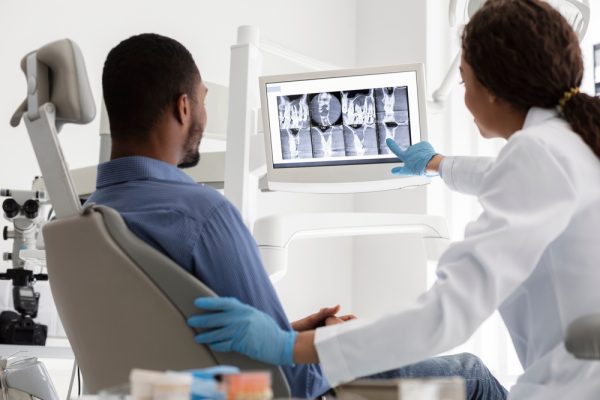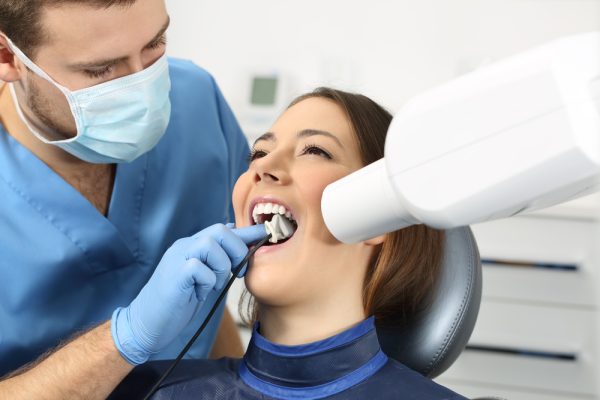The Importance of X-rays During Dental Cleaning Appointments
Maintaining good oral health is an essential aspect of overall health and well-being. Regular dental cleanings are crucial in preventing dental problems such as gum disease, cavities, and tooth decay.
X-rays play an essential role in dental cleanings by providing a more comprehensive view of your teeth, allowing your dentist to identify any underlying dental problems that may not be visible to the naked eye.
What Are Dental X-rays?
Dental X-rays are diagnostic images that use low radiation levels to capture images of the teeth, gums, and jawbone. These images help our Wasilla dentist evaluate the health of your teeth and identify any potential dental problems. Dental X-rays are also useful in developing treatment plans for dental procedures such as root canals, braces, and dental implants.

How Dental X-rays Are Used for Dental Cleanings
During a dental cleaning, your dentist or dental hygienist will use X-rays to identify any dental problems that may not be visible during a routine dental exam. Dental X-rays can reveal dental problems such as decay, bone loss, cysts, and tumors. They can also show the position of teeth that have not yet erupted, and help identify any problems with existing dental restorations such as fillings, crowns, and bridges.
How Often Should You Get Dental X-rays?
The frequency of dental X-rays depends on your age, dental history, and risk of developing dental problems. Generally, adults with a low risk of developing dental problems may only need X-rays every two to three years. However, individuals with a higher risk of developing dental problems may need X-rays more frequently, such as every six months to a year.
Types of Dental X-Rays
There are various types of dental X-rays, including:
- Bitewing X-rays: This type of X-ray shows the upper and lower back teeth in a single view, and is often used to check for decay between teeth and the fit of crowns (caps) and fillings.
- Periapical X-rays: These show the entire tooth, from the crown to the root where the tooth is anchored in the jaw. Each periapical X-ray shows all the teeth in one portion of either the upper or lower jaw.
- Occlusal X-rays: These are larger, and they can show a roof or a floor of the mouth to help find extra teeth, teeth that have not yet broken through the gums, jaw fractures, a cleft in the roof of the mouth (cleft palate), cysts, abscesses, or growths.
- Panoramic X-rays: Unlike other X-rays where the film is placed inside the patient’s mouth, the film for a panoramic X-ray machine is contained inside the machine and moves around the outside of the head. Panoramic X-rays show a broad view of the jaws, teeth, sinuses, nasal area, and TMJ (temporomandibular joints).
- Cephalometric X-rays: This type of X-ray is used by orthodontists to view the entire side of the head. This helps to assess the relationships of the teeth to the jaw and the jaw to the skull.
- Cone Beam CT: A type of X-ray that provides 3D images. It offers a detailed view of the bones, teeth, and supporting structures of the mouth and jaw. It is more detailed than a standard X-ray but also involves more radiation.
- Dental Computed Tomography (CT): This type of imaging provides a three-dimensional (3D) view so that your dentist can better gauge the size and location of a dental structure in a way that is not possible with 2D imaging.
Concerns About Radiation
Dental X-rays use low levels of radiation. However, some people may have concerns about the safety of these procedures. The amount of radiation exposure during a dental X-ray is minimal and considered safe for most individuals. Additionally, your dentist takes precautions to limit radiation exposure, such as using lead aprons and thyroid collars to protect the patient from unnecessary exposure.

Frequently Asked Questions
The risks associated with dental X-rays during pregnancy are minimal. However, it’s generally recommended that pregnant women avoid dental X-rays unless necessary. If dental X-rays are necessary during pregnancy, the dentist will take precautions to protect the fetus, such as using a lead apron and thyroid collar to shield the abdomen and neck.
Yes, dental X-rays are an essential part of monitoring children’s dental development and identifying any potential dental problems that may not be visible during a routine dental exam.
X-rays can help detect:
- Cavities
- Issues with their bite
- Teeth or jaw misalignment
While X-rays do expose children to low radiation levels, the amount is considered safe, and dental professionals take precautions to limit radiation exposure. The American Dental Association recommends that children receive dental X-rays as part of their routine dental care, with the frequency determined by their needs and risk factors.
There’s no special preparation required for a dental X-ray. However, you should avoid wearing jewelry as it can interfere with the X-rays process. You should also inform your dentist if you are pregnant or suspect that you may be pregnant.
Protect Your Smile With Regular Dental X-rays
Dental X-rays are a crucial component of dental cleanings, allowing dentists to identify potential dental problems that may not be visible during a routine dental exam. You can maintain good oral health and prevent dental problems from developing by following a regular dental cleaning schedule and getting X-rays.
If you live in Wasilla, contact our dentist to schedule your next cleaning!
